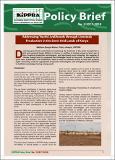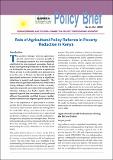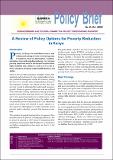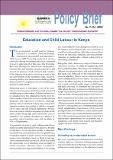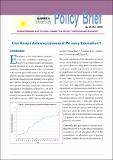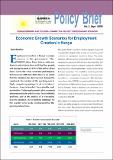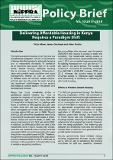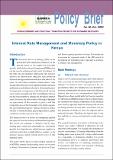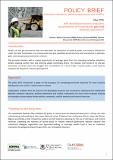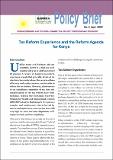Search
Now showing items 1-10 of 23
Policy Brief No. 2 of 2004 on Fiscal Strategies and Poverty in Kenya: Agenda for Reform
(The Kenya Institute for Public Policy Research and Analysis (KIPPRA), 2004)
Historically, Kenya’s development policy has combined the objectives of economic growth with equity and poverty reduction. Although there were improvements in social welfare indicators in the late 1980s, these achievements ...
Policy Brief No. 6 of 2004 on Role of Agricultural Policy Reforms in Poverty Reduction in Kenya
(The Kenya Institute for Public Policy Research and Analysis, 2004)
This policy brief is based on a study on the Role of agricultural policy reforms in poverty reduction: Implication for economic recovery strategy for wealth and employment creation. The aim of the study is to contribute ...
Policy Brief No. 9 of 2004 on a Review of Policy Options for Poverty Reduction in Kenya.
(The Kenya Institute for Public Policy Research and Analysis, 2004)
Poverty in Kenya is multidimensional and widespread among all socio-economic groups. It manifests itself in deprivation, isolation, alienation, insecurity and despondency. Low-income poverty manifests itself in the form ...
Policy Brief No. 7 of 2004 on Education and Child Labour in Kenya
(The Kenya Institute for Public Policy Research and Analysis, 2004)
This policy brief is based on a study on Education and child labour in Kenya. The study investigates the child labour-schooling trade-off owing to the fact that those children who are not in school end up in child labour. ...
Policy Brief No. 8 of 2004 on Can Kenya Achieve Universal Primary Education
(The Kenya Institute for Public Policy Research and Analysis, 2004)
Education is the main factor associated with the probability of being poor. Improving educational performance should therefore be a core element in poverty reduction. Since independence, the Government of Kenya has given ...
Policy Brief No. 1 of 2004 on Economic Growth Scenarios for Employment Creation in Kenya
(The Kenya Institute for Public Policy Research and Analysis, 2004)
Employment creation in Kenya is a major concern to the government. The 1998/99 Labour Force Survey estimates Kenya’s active labour force at 10.5 million people, and unemployment at 14.6% of the active labour force. Given ...
Policy Brief No. 10 of 2017-2018 on Delivering Affordable Housing in Kenya Requires a Paradigm Shift
(The Kenya Institute for Public Policy Research and Analysis (KIPPRA), 2017)
The right to a decent housing by all Kenyans is a constitutional obligation. The 2010 Constitution
of Kenya identifies access to adequate housing and to reasonable standards of sanitation as an economic and social right. ...
Policy Brief No. 10 of 2004 on Interest Rate Management and Monetary Policy in Kenya
(The Kenya Institute for Public Policy Research and Analysis, 2004)
The Economic Recovery Strategy (ERS) for the
period 2003-2007 emphasizes on the role of the
private sector as the engine for economic
growth, while the Investment Programme (2003) points
out the need to enhance private ...
Policy Brief on Extractive Industries, Political Settlements and Conflict
(The Kenya Institute for Public Policy Research and Analysis (KIPPRA), 2016)
Kenya's oil and gas discoveries have coincided with the devolution of political power and resource distribution under the 2010 Constitution. The mining sector has also expanded during this time with investments in titanium, ...
Policy Brief No. 3 of 2004 on Tax Reform Experience and the Reform Agenda for Kenya
(The Kenya Institute for Public Policy Research and Analysis, 2004)
Unlike many sub-Saharan African countries, Kenya is a high tax yield country with a tax to GDP ratio of over 20 percent. A review of Kenya’s tax reform experience reveals that generally, levels of tax rates have been reduced ...

